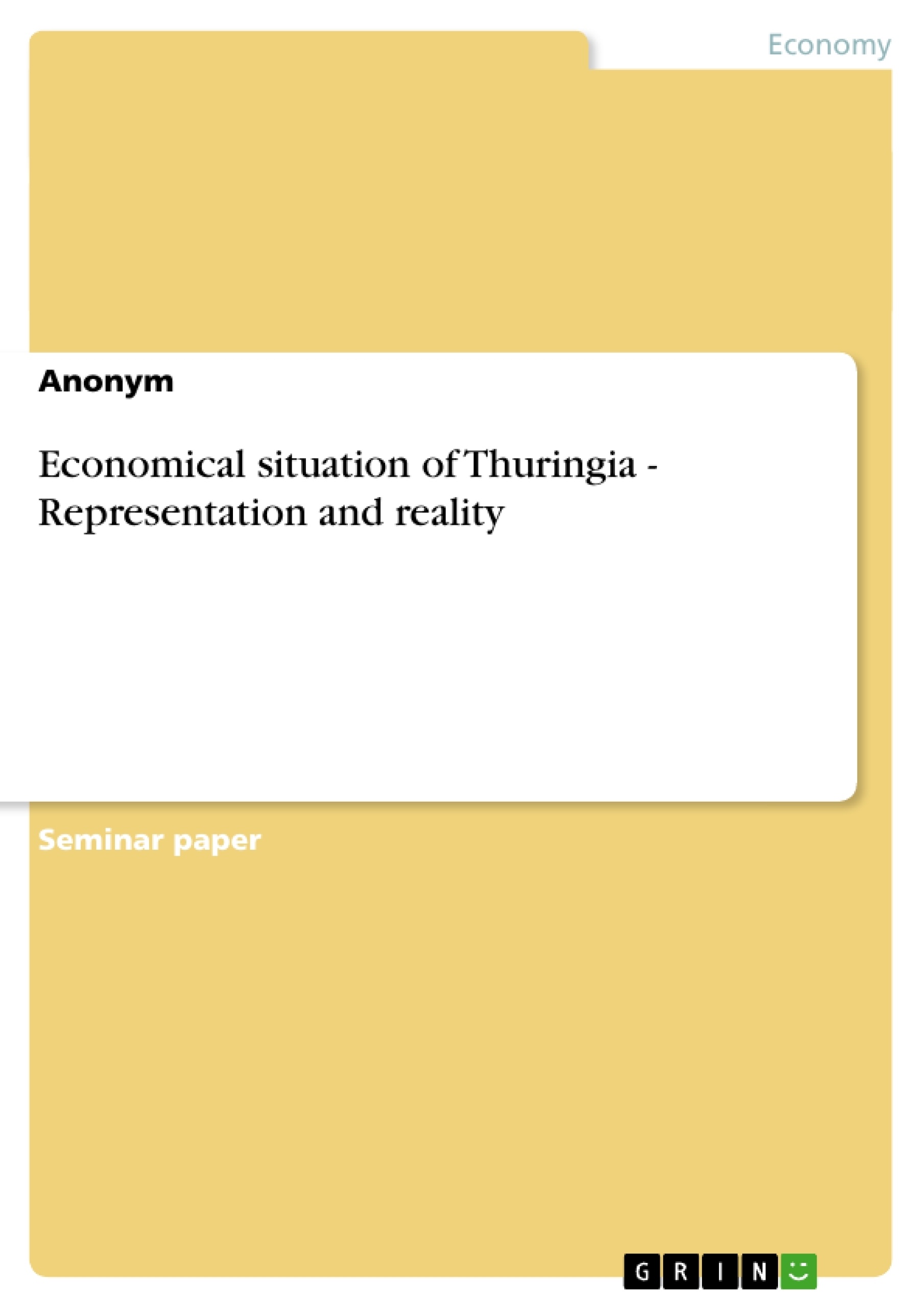Introduction
Free state Thuringia - mentioned the strong middle of Germany or also the green heart of Germany. Nevertheless, is this also valid for the economical aspect of the country? Can Thuringia really keep up with the other federal states or be designated even as the economically strong middle of Germany? Be called as the heart of Germany, without which the circuit of the economy would stop turning?
" This state has always offered something special. Thuringia has always been involved in research and modern technology concerning cars, optical instruments, office machines, medical science, or famous colleges and universities. (...) The state`s efficient traffic links are being extended on a continuous basis. They have converted Thuringia into a hub of trade routes and into an advantageous location for national and international business activities, which take advantage of the state`s central position both in Germany and in the expanded European Union. (...) ... intensive research and development activities conducted with a view to satisfying business needs in addition to an efficient system for knowledge transfer have led to the creation of products which are often unique on the market.
A state policy consistently geared to business needs, development organizations run by the state, and practical promotion activities have been instrumental in creating an innovative dynamism in business life which is attracting new companies, and provides room for many different projects in the state`s budding economy...
(Franz Schuster - minister of Thuringia for economy, employment and infrastructure; Pamphlet of the ministry)
These are the words of a minister making propaganda for his state, covered by a pamphlet with inviting pictures.
I would like to consider this statement from several point of views and try to find out whether it`s a realistic representation.
On the one hand the overall economy of the state ( also in comparison with other states ) and on the other hand individual sections will be analyzed in order to prove or refute this .
Inhaltsverzeichnis (Table of Contents)
- 1. INTRODUCTION
- 2. MACROECONOMIC EVOLUTION OF THE FREE STATE
- 2.1. Conditions
- 2.2. Tasks
- 3. THURINGIA TODAY
- 3.1. Infrastructure
- 3.2. Economic structure
- 3.3. Foreign market
- 3.4. Employment
- 3.5. Power Supply
- 3.6. Communications
- 3.7. Education
- 4. THURINGIA IN COMPARISON WITH THE NEW FEDERAL STATES
- 4.1. Gross domestic product
- 4.2. Density of industrial companies
- 5. NATIONWIDE COMPARISON
- 5.1. Gross value creation
- 5.2. Households
- 5.3. Unemployment
- 5.4. Gross plant investments
- 5.5. Completion
- 6. PROBLEMS TO ELIMINATE IN THE FUTURE (DESTINATIONS )
- 6.1. Situation on the labor market
- 6.2. Increase of the quality of location
- 6.3. Locational advertising
- 6.4. Protection of the specialist requirement
- 6.5. Evolution of the wages and earnings
- 6.6. Course correction in the budget policy
- 7. RESULT
Zielsetzung und Themenschwerpunkte (Objectives and Key Themes)
This text aims to analyze the economic situation of Thuringia, examining its representation in official pronouncements and comparing it to actual reality. The work focuses on understanding the economic evolution of the state, particularly in the context of its post-unification transition.
- Economic Performance and Development of Thuringia
- Comparison of Thuringia's Economy with Other German States
- Key Challenges and Opportunities for Future Economic Growth in Thuringia
- Analysis of the Impact of Infrastructure and Investment on Economic Development
- The Role of Government Policy in Shaping the Economic Landscape of Thuringia
Zusammenfassung der Kapitel (Chapter Summaries)
- The introduction sets the stage by discussing Thuringia's historical economic context and its current position within Germany. The author questions whether the state's economic reality matches the positive portrayal often presented in official publications.
- Chapter 2 explores the macroeconomic evolution of Thuringia, examining the conditions and tasks that have shaped its economic trajectory. It highlights the changes that have occurred since reunification and the challenges associated with transitioning from a centrally planned economy to a market-driven system.
- Chapter 3 focuses on the current economic situation in Thuringia, discussing its infrastructure, economic structure, foreign market performance, employment, power supply, communications, and education system. It examines the progress made in developing these areas and any remaining challenges.
- Chapter 4 compares Thuringia's economic performance with other new federal states, specifically focusing on indicators like gross domestic product and the density of industrial companies.
- Chapter 5 delves into a nationwide comparison, analyzing Thuringia's performance in terms of gross value creation, household indicators, unemployment rates, gross plant investments, and overall economic completion.
- Chapter 6 examines the key challenges and opportunities for future economic growth in Thuringia. It discusses issues such as labor market conditions, improving location quality, promoting Thuringia as a business destination, safeguarding specialist requirements, evolving wages and earnings, and ensuring a sound budget policy.
Schlüsselwörter (Keywords)
This work explores the economic situation of Thuringia, focusing on key areas like the state's macroeconomic evolution, infrastructure development, industrial structure, employment trends, and comparison with other German states. The analysis considers the impact of post-unification transition, government policies, and the challenges and opportunities for future economic growth.
- Quote paper
- Anonym (Author), 2002, Economical situation of Thuringia - Representation and reality, Munich, GRIN Verlag, https://www.grin.com/document/12943



